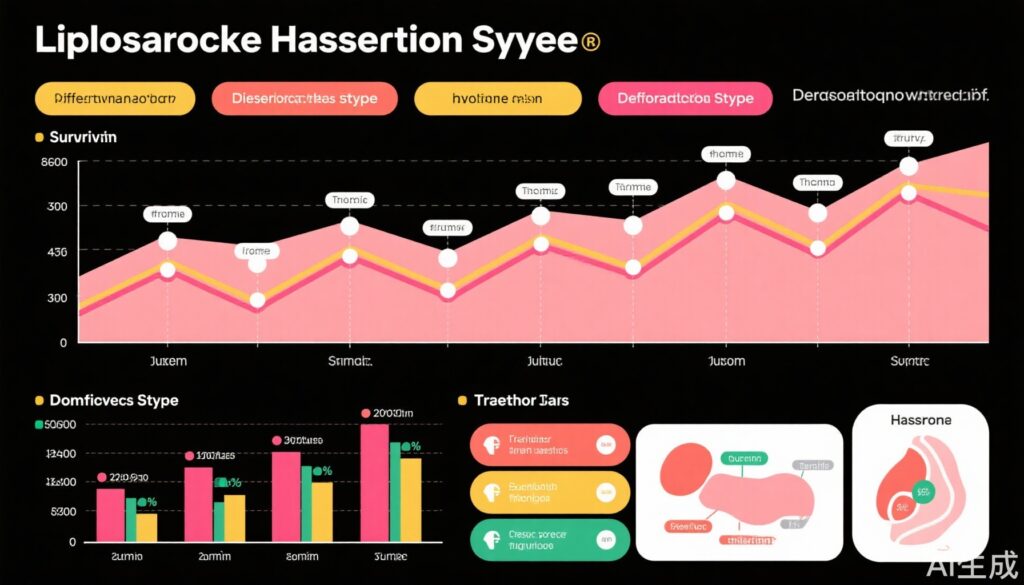Highlights
- Largest population-based analysis of 11,132 histologically confirmed liposarcoma (LPS) patients from the NETSARC+ registry (2010–2023).
- Diverse LPS subtypes exhibit distinct clinical presentations, anatomical distributions, and survival outcomes.
- Dedifferentiated liposarcoma (DDLPS) is the most prevalent subtype with the poorest median overall survival (144 months).
- Age- and sex-related differences influence incidence and prognosis, notably improved survival in women over 50 years.
- Multidisciplinary management through specialized sarcoma centers enhances quality of care.
Background
Liposarcomas (LPS) account among the most common soft tissue sarcomas, comprising a heterogeneous group of mesenchymal malignancies with distinct molecular profiles and clinical behavior. Previous studies have limited scope in sample size or subtype characterization, impeding comprehensive understanding of natural history, prognosis, and optimal management stratified by LPS histotypes. The French NETSARC+ network, established by the National Cancer Institute (INCA) in 2010, integrates 26 reference sarcoma centers with central pathology review and multidisciplinary tumor boards (MDTBs), providing a robust infrastructure for nationwide data capture, quality assurance, and outcome monitoring in sarcomas.
This study’s aim was to elucidate the clinical presentation, management patterns, and outcomes across the spectrum of LPS histological subtypes using a large population-based cohort within the NETSARC+ registry.
Key Content
Study Design and Patient Population
This retrospective cohort included all patients with LPS diagnosed between 2010 and 2023, confirmed by central pathology review in the NETSARC+ database. The cohort comprised 11,132 patients, providing a rare comprehensive assessment of LPS subtypes with demographic, anatomical, treatment, and survival data.
Histological Subtypes and Demographics
The subtypes distribution was: dedifferentiated liposarcoma (DDLPS) 37.9%, well-differentiated LPS (WDLPS) 16.5%, atypical lipomatous tumor (ALT) 21.8%, myxoid LPS (MyxLPS) 12.3%, pleomorphic LPS (PLPS) 4.0%, high-grade myxoid LPS (HGMLPS) 1.6%, mixed-type (MTLPS) 0.2%, myxoid pleomorphic (MPLPS) 0.1%, and non-classified LPS (NCLPS) 5.5%. Median age was 65 years, with a male predominance (58.7%). Subtype-specific age and site distribution varied: DDLPS and WDLPS were more common in older adults, while rare subtypes appeared across wide age ranges.
A novel observation was age-related sex ratio changes for select histotypes (DDLPS, MyxLPS, HGMLPS), where postmenopausal women (>50 years) were less frequently affected but showed better relapse-free survival (RFS) and overall survival (OS) compared to age-matched men.
Clinical Presentation and Anatomical Sites
LPS locations differed by histotype, with retroperitoneum being common for DDLPS and WDLPS, while MyxLPS and PLPS had more frequent extremity involvement. ALT predominantly affected superficial soft tissues.
Treatment Approaches
Management involved surgical resection with curative intent, complemented by radiotherapy or systemic therapies per MDTB recommendations. The registry highlighted variations in treatment intensity based on histotype, tumor size, grade, and patient age.
Survival Outcomes and Prognostic Factors
Median OS varied significantly by subtype: DDLPS had the worst prognosis (median OS 144 months), significantly lower than MyxLPS (hazard ratio [HR] 0.26), WDLPS (HR 0.30), HGMLPS (HR 0.30), PLPS (HR 0.76), and unclassified LPS (HR 0.53). Kaplan-Meier survival analyses underscored DDLPS as the subtype with the highest mortality.
Multivariate analysis controlling for tumor size, age, and sex confirmed these variables as independent prognostic factors. Notably, female sex over 50 years was an independent favorable prognostic marker in DDLPS, indicating potential hormonal or biological influences.
Size was a consistent prognostic factor across subtype analyses, with larger tumors portending worse survival.
Comparisons with Other Recent Sarcoma Studies
Contemporary studies (e.g., molecular classifications by Xiao et al., 2025) demonstrated heterogeneity within retroperitoneal LPS, correlating molecular markers (LEP and PTTG1) with clinical aggressiveness, paralleling NETSARC+ findings on histotype survival differences. Trials in systemic therapies (e.g., trabectedin plus olaparib, 2025) reflect ongoing efforts to improve outcomes in advanced LPS subtypes, albeit with mixed results.
Expert Commentary
The NETSARC+ registry study advances our epidemiologic and clinical knowledge of LPS, leveraging centralized pathology and multidisciplinary management frameworks, which likely enhance the reliability and generalizability of the findings.
The significant prognostic disparity between DDLPS and other subtypes necessitates intensified research into tailored therapies and biomarker-driven risk stratification. The observed sex- and age-specific survival patterns warrant exploration into hormonal, genetic, or immune mechanisms influencing tumor biology.
The broad inclusion across rare and ultrarare subtypes addresses previous gaps but also highlights the need for international collaboration and molecularly driven clinical trials to optimize management.
Limitations include the retrospective design and variable therapeutic modalities over the 13-year period. Nonetheless, real-world data from an integrated national network offer valuable insights reflective of routine clinical practice.
Conclusion
This large, comprehensive population-based study details the demographic, clinical, pathologic, and outcome heterogeneity across liposarcoma subtypes. Dedifferentiated liposarcoma emerges as the subtype with the worst prognosis. Age and sex notably influence disease presentation and survival, with better outcomes observed in women over 50.
The NETSARC+ registry underscores the importance of specialized multidisciplinary sarcoma centers for accurate diagnosis and optimal patient management. Future research directions include refinement of prognostic biomarkers, molecular subclassification integration, and development of targeted therapies to improve outcomes in high-risk LPS subtypes.
References
- Blay JY et al. Clinical presentation, management and outcome of 11,132 patients with liposarcoma patients: a population-based study from the NETSARC+ registry. Lancet Reg Health Eur. 2025 Jul 31;57:101403. doi: 10.1016/j.lanepe.2025.101403. PMID: 40799506; PMCID: PMC12336835.
- Xiao et al. Molecular feature-based classification of retroperitoneal liposarcoma: a prospective cohort study. Elife. 2025 May 23;14:RP100887. doi:10.7554/eLife.100887. PMID: 40407808.
- Brahmi M et al. A Phase II Multicenter Trial of Trabectedin in Combination with Olaparib in Patients with Advanced Unresectable or Metastatic Sarcoma. Clin Cancer Res. 2025 Jul 15;31(14):2919-2925. doi:10.1158/1078-0432.CCR-25-0298. PMID: 40358615.



